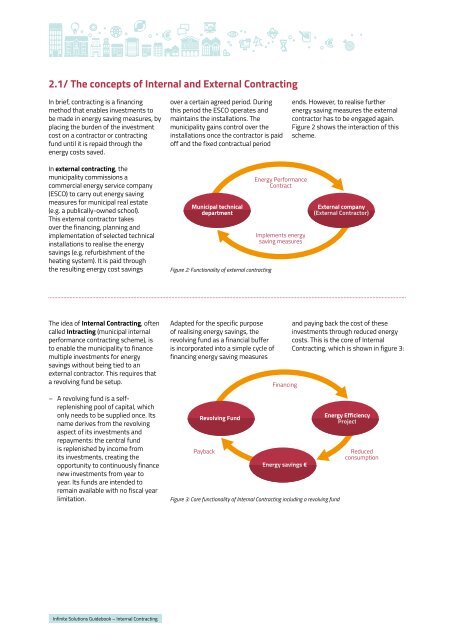Contracting
guidebook_intracting_web
guidebook_intracting_web
Create successful ePaper yourself
Turn your PDF publications into a flip-book with our unique Google optimized e-Paper software.
BUILDING DEPARTMENT<br />
Energy Saving blocks<br />
other building investments<br />
No incentive,<br />
as no direct benefit<br />
Construction/<br />
ACCOUNTING DEPARTMENT<br />
physical<br />
implementation<br />
Not qualified/authorised for<br />
investment decisions<br />
Tight budget for earmarked<br />
operating costs<br />
2.1/ The concepts of Internal and External <strong>Contracting</strong><br />
In brief, contracting is a financing<br />
method that enables investments to<br />
be made in energy saving measures, by<br />
placing the burden of the investment<br />
cost on a contractor or contracting<br />
fund until it is repaid through the<br />
energy costs saved.<br />
In external contracting, the<br />
municipality commissions a<br />
commercial energy service company<br />
(ESCO) to carry out energy saving<br />
measures for municipal real estate<br />
(e.g. a publically-owned school).<br />
This external contractor takes<br />
over the financing, planning and<br />
implementation of selected technical<br />
installations to realise the energy<br />
savings (e.g. refurbishment of the<br />
heating system). It is paid through<br />
the resulting energy cost savings<br />
BUILDING DEPARTMENT<br />
ACCOUNTING DEPARTMENT<br />
Special budget for energy saving investments<br />
Long-term holistic approach considering total costs and benefits of projects<br />
over Energy a certain Saving agreed blocks period. During Not ends. qualified/authorised However, to realise for further<br />
other building investments<br />
investment decisions<br />
this period the Department ESCO operates responsible and<br />
for Internal energy <strong>Contracting</strong> saving measures the external<br />
maintains No incentive, the installations. The<br />
Tight contractor budget has for earmarked<br />
to be engaged again.<br />
as no direct benefit<br />
operating costs<br />
municipality gains control over the Figure 2 shows the interaction of this<br />
installations once the contractor is paid scheme.<br />
off and the fixed contractual period<br />
Special budget for energy saving investments<br />
Long-term holistic approach considering total costs and benefits of projects<br />
Department responsible Energy Performance<br />
Internal <strong>Contracting</strong><br />
Contract<br />
Municipal technical<br />
department<br />
Figure 2: Functionality of external contracting<br />
Municipal technical<br />
department<br />
Implements energy<br />
saving measures<br />
Energy Performance<br />
Contract<br />
External company<br />
(External Contractor)<br />
External company<br />
(External Contractor)<br />
The idea of Internal <strong>Contracting</strong>, often<br />
called Intracting (municipal internal<br />
performance contracting scheme), is<br />
to enable the municipality to finance<br />
multiple investments for energy<br />
savings without being tied to an<br />
external contractor. This requires that<br />
a revolving fund be setup.<br />
– A revolving fund is a selfreplenishing<br />
pool of capital, which<br />
only needs to be supplied once. Its<br />
name derives from the revolving<br />
aspect of its investments and<br />
repayments: the central fund<br />
is replenished by income from<br />
its investments, creating the<br />
opportunity to continuously finance<br />
new investments from year to<br />
year. Its funds are intended to<br />
remain available with no fiscal year<br />
limitation.<br />
Infinite Solutions Guidebook – Internal <strong>Contracting</strong><br />
Adapted for the specific purpose<br />
of realising energy savings, the<br />
revolving fund as a financial buffer<br />
is incorporated Revolving into Fund a simple cycle of<br />
financing energy saving measures<br />
Payback<br />
Payback<br />
Municipal<br />
departments time line<br />
Energy<br />
department<br />
Financing<br />
Energy savings €<br />
internal<br />
Figure 3: Core functionality of Internal <strong>Contracting</strong> including a revolving contracting fund<br />
Facility<br />
agreement<br />
department<br />
funding<br />
owner<br />
Municipal<br />
departments<br />
Construction<br />
department<br />
Energy<br />
department<br />
Facility<br />
department<br />
Construction<br />
department<br />
Revolving Fund<br />
identifies energy<br />
saving measure<br />
time line<br />
identifies energy<br />
saving measure<br />
owner<br />
Implements energy<br />
saving measures<br />
calculates<br />
energy savings<br />
calculates<br />
investment cost<br />
Financing<br />
Energy savings €<br />
calculates<br />
energy savings<br />
calculates<br />
investment cost<br />
and paying back the cost of these<br />
investments through reduced energy<br />
costs. This is the core of Internal<br />
<strong>Contracting</strong>, Energy which Efficiency is shown in figure 3:<br />
Project<br />
implements ents<br />
measure e<br />
Reduced<br />
consumption<br />
Energy Efficiency<br />
Project<br />
internal<br />
contracting<br />
agreement<br />
funding<br />
implements ents<br />
measure e<br />
Reduced<br />
consumption<br />
revolv.<br />
fund<br />
energy cost<br />
savings<br />
- /a<br />
revolv.<br />
fund<br />
energy cost<br />
savings<br />
- /a<br />
annual<br />
payback<br />
annual<br />
payback


